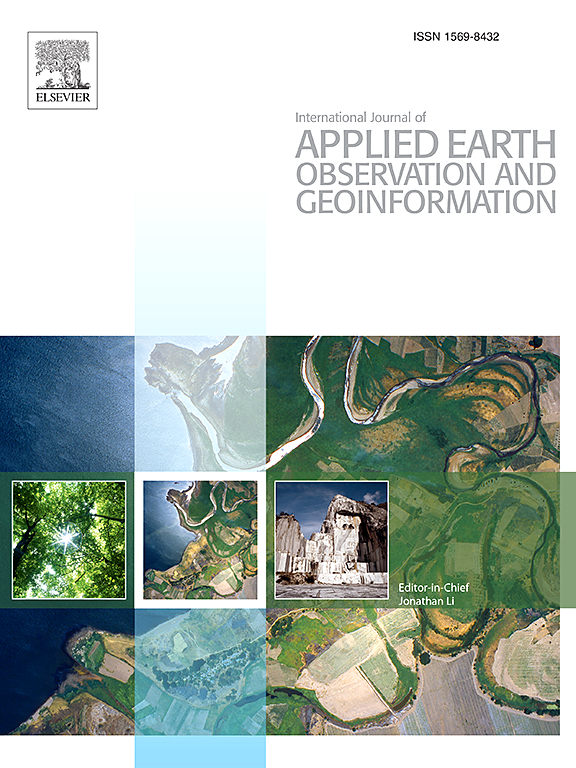GCOANet: A gradient consistency constraints semi-supervised network for optical image-assisted SAR despeckling
IF 8.6
Q1 REMOTE SENSING
International journal of applied earth observation and geoinformation : ITC journal
Pub Date : 2025-06-19
DOI:10.1016/j.jag.2025.104677
引用次数: 0
Abstract
Synthetic Aperture Radar (SAR), as an active remote sensing technology with all-weather and all-time capabilities, plays an essential role in environmental monitoring and disaster management. However, SAR employed the coherent imaging mechanism to synthesize images, inevitably introducing speckles in the obtained images. These speckles reduce the signal-to-noise ratio of an image due to the random variation of image pixel value, which brings challenges for subsequent applications. The breakthrough of image registration provides the data requirements for acquiring multi-source remote sensing data. Based on the above study, this paper presents a Gradient Consistency constraints semi-supervised network for Optical image-Assisted SAR despeckling (GCOANet). The presented method generates cross-domain reference images by utilizing optical pixel correlation to conduct the paired SAR reconstruction, thereby mitigating feature misalignment caused by the modal differences between SAR and optical imagery. The conditional diffusion model is then employed to learn the mapping between the SAR and reference images, eliminating the necessity for paired SAR/optical data. The reference image is first generated using a pre-trained conditional diffusion model during the training and test phase. Subsequently, a multi-scale blind spot despeckling network is designed to suppress speckles by fusing SAR and reference features, while also preventing the loss of blind pixel information. Finally, an all-directional gradient loss is proposed to rapidly differentiate homogeneous and heterogeneous regions and achieve separate speckle suppression. Extensive experiments conducted on both real and simulated data verify the effectiveness of the presented method, which retains complete texture details and smooth homogeneous areas. Furthermore, the related applications further demonstrate the efficiency of the proposed method in real-world scenarios.
GCOANet:用于光学图像辅助SAR消斑的梯度一致性约束半监督网络
合成孔径雷达(SAR)作为一种全天候、全天候的主动遥感技术,在环境监测和灾害管理中发挥着重要作用。然而,SAR采用相干成像机制合成图像,不可避免地会在获得的图像中引入斑点。这些斑点由于图像像素值的随机变化,降低了图像的信噪比,给后续的应用带来了挑战。图像配准的突破为获取多源遥感数据提供了数据需求。在此基础上,提出了一种梯度一致性约束的光学图像辅助SAR消斑(GCOANet)半监督网络。该方法利用光学像元相关性生成跨域参考图像,对SAR进行配对重建,从而减轻了SAR与光学图像模态差异带来的特征错位。然后使用条件扩散模型来学习SAR和参考图像之间的映射,从而消除了配对SAR/光学数据的必要性。在训练和测试阶段,首先使用预训练的条件扩散模型生成参考图像。随后,设计了一种多尺度盲点去斑网络,通过融合SAR和参考特征来抑制斑点,同时防止盲像素信息的丢失。最后,提出了一种全方位梯度损失算法,用于快速区分均匀区和非均匀区,实现单独的散斑抑制。在真实和模拟数据上进行的大量实验验证了该方法的有效性,该方法保留了完整的纹理细节和光滑的均匀区域。此外,相关应用进一步证明了该方法在实际场景中的有效性。
本文章由计算机程序翻译,如有差异,请以英文原文为准。
求助全文
约1分钟内获得全文
求助全文
来源期刊

International journal of applied earth observation and geoinformation : ITC journal
Global and Planetary Change, Management, Monitoring, Policy and Law, Earth-Surface Processes, Computers in Earth Sciences
CiteScore
12.00
自引率
0.00%
发文量
0
审稿时长
77 days
期刊介绍:
The International Journal of Applied Earth Observation and Geoinformation publishes original papers that utilize earth observation data for natural resource and environmental inventory and management. These data primarily originate from remote sensing platforms, including satellites and aircraft, supplemented by surface and subsurface measurements. Addressing natural resources such as forests, agricultural land, soils, and water, as well as environmental concerns like biodiversity, land degradation, and hazards, the journal explores conceptual and data-driven approaches. It covers geoinformation themes like capturing, databasing, visualization, interpretation, data quality, and spatial uncertainty.
 求助内容:
求助内容: 应助结果提醒方式:
应助结果提醒方式:


